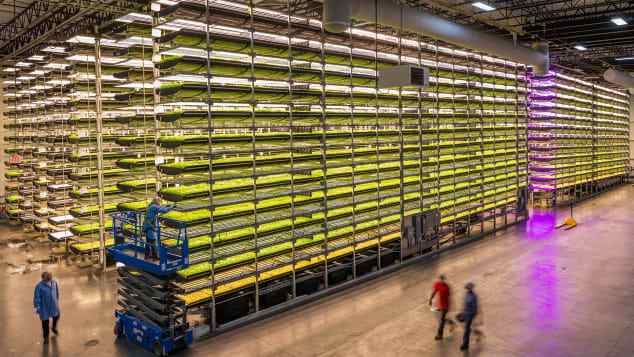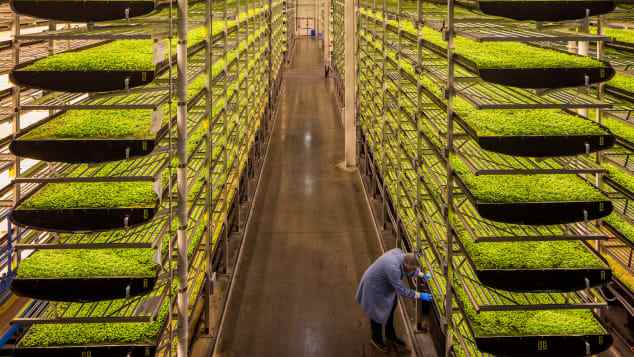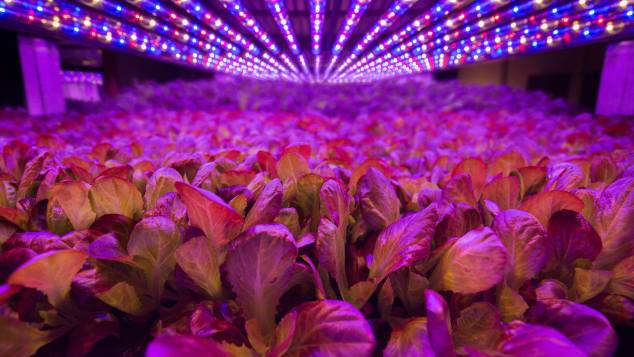Singapore Airlines uses aeroponics technology to improve the quality of in-flight meals
- Tram Ho
Nobody thought a gloomy warehouse in Newark, New Jersey was a green vegetable farm. Each stack is made up of light boxes that are connected to electronic sensors. There is no soil, no honey bee, and no “faint” fertilizer smell.
That’s the usual setting inside the AeroFarms facility in Newark, known as the world’s largest indoor standing farm – at least until the company’s $ 42 million farm in Virginia is completed. This 16-year-old agricultural technology startup has brought aerospace technology to an industrial scale, with about 800 types of greenery, tubers, tubers, grapes, and berries without soil, sunlight, or pesticides. The only things they can’t produce are fruits that grow on trees – according to AeroFarms co-founder, Marc Oshima.

You may have heard about the aeroponics technique used by NASA to grow vegetables in this space. Instead of burying it in the ground, the roots are exposed and directed to the sky. Plants are grown with dew and a controlled amount of light and air. An aeroponics farm will be 300% more efficient than a traditional farm in terms of output, though this model is criticized quite a lot for consuming a significant amount of power to maintain the computer system. , lights, high pressure valves, and sprinklers.
Restaurant owners like David Chang (Momofuku), Marcus Samuelsson (Red Rooster), and Facebook CEO Anthony Moraes are “crazy” about the “flavor density” of products produced by AeroFarms. Because environmental factors can be adjusted during planting, chefs may request sweeter kale, or more spicy, high-yield rocket (Arugula) to match a recipe. certain.

Arugula vegetables are extremely hard to grow – according to Oshima; and unusually cold and wet weather conditions in Arizona this year caused a severe shortage of Arugula vegetables in 2020. Oshima explained that they were racing to meet market demand, because the AeroFarms’ cultivation process is not dependent on natural weather conditions and can produce green leafy vegetables in only half the time compared to traditional cultivation. “Our orders are piling up,” he said.
Antony McNeail, Singapore Airlines’ global director of food and beverage, was recently convinced of this model. ” When you first hear about it, you find it strange – lettuce growing on a shelf, LED lights … I’m not sure if it can be done that way, ” he said. A veteran Australian chef, who previously managed the kitchens at the Ritz Carlton, Hilton, and Emirates Airlines, McNeil said that being able to serve passengers with the most delicious and fresh products most persuaded him to accept AeroFarms.
The fresh element is the most appealing thing. Most commercial airlines use traditionally grown greens, harvested three to five weeks before being included on board meals. Singapore Airlines is the first major airline to service harvested products just hours before a flight. JetBlue also has a similar farm-to-plane delivery program, but uses traditional farming on rooftop gardens at John F. Kennedy Airport (New York).
” We now have the best opportunity to serve the latest fresh produce, and not have to transport them for 2,000 miles, ” McNeil said.
But are classic-trained chefs concerned about lab-grown vegetables, as many are currently concerned about genetically engineered meat products? After all, tweaking the colors, flavors, and textures of a product according to a chef’s wishes is a strange ability. However, McNeil did not seem to notice much. “I have no complaints because it is not a blended product. It is fresh, and produced in a clean and tidy way,” he explained.

AeroFarms customized orders by changing the growing conditions of the environment; For example, increasing the wind speed on a farm produces a stronger kale. “It is beyond imagination, ” McNeil said. In addition to quality, McNeail says that capturing data showing where and how to grow vegetables is a time-saving solution – especially for airlines where food safety is paramount. Food served onboard must undergo 10-12 key control points during transportation from harvest to serving.
Singapore Airlines currently serves AeroFarms-manufactured products on flights departing from Newark and JFK airports. McNeail said that Singapore Airlines’ plan is to expand the company’s sustainable grower network to serve more routes around the world.
Reference: Quartz
Source : Genk
